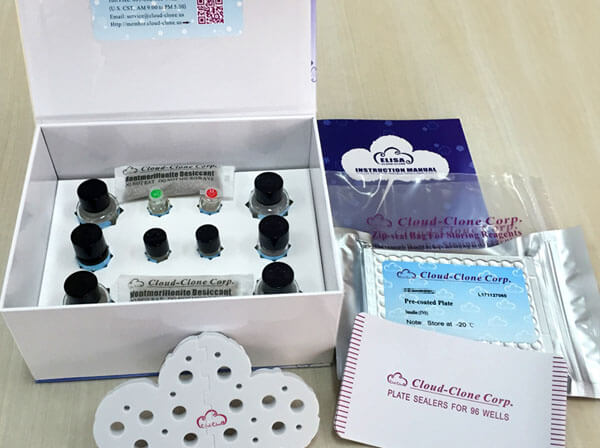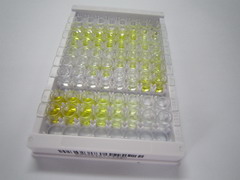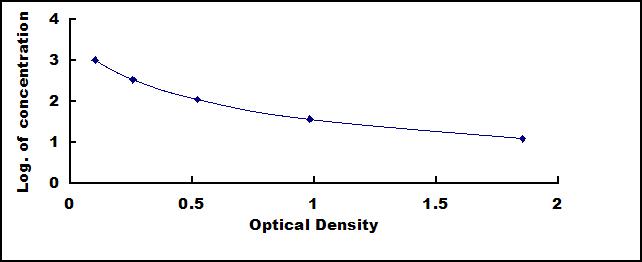ELISA Kit for Acetylcholine (ACH) 

- UOM
- FOB US$ 557.00 US$ 796.00 US$ 3,580.00 US$ 6,763.00 US$ 55,692.00
- Quantity
Overview
Properties
- Product No.CEA912Ge
- Organism SpeciesPan-species (General) Same name, Different species.
- ApplicationsEnzyme-linked immunosorbent assay for Antigen Detection.
Research use only - DownloadInstruction Manual
- CategorySignal transductionInfection immunityNeuro science
Sign into your account
Share a new citation as an author
Upload your experimental result
Review

Contact us
Please fill in the blank.
Recovery
Matrices listed below were spiked with certain level of Acetylcholine (ACH) and the recovery rates were calculated by comparing the measured value to the expected amount of Acetylcholine (ACH) in samples.
| Matrix | Recovery range (%) | Average(%) |
| serum(n=5) | 79-98 | 89 |
| EDTA plasma(n=5) | 89-98 | 94 |
| heparin plasma(n=5) | 83-97 | 86 |
Precision
Intra-assay Precision (Precision within an assay): 3 samples with low, middle and high level Acetylcholine (ACH) were tested 20 times on one plate, respectively.
Inter-assay Precision (Precision between assays): 3 samples with low, middle and high level Acetylcholine (ACH) were tested on 3 different plates, 8 replicates in each plate.
CV(%) = SD/meanX100
Intra-Assay: CV<10%
Inter-Assay: CV<12%
Linearity
The linearity of the kit was assayed by testing samples spiked with appropriate concentration of Acetylcholine (ACH) and their serial dilutions. The results were demonstrated by the percentage of calculated concentration to the expected.
| Sample | 1:2 | 1:4 | 1:8 | 1:16 |
| serum(n=5) | 93-102% | 97-105% | 84-91% | 83-91% |
| EDTA plasma(n=5) | 84-104% | 83-93% | 80-90% | 78-102% |
| heparin plasma(n=5) | 80-91% | 96-104% | 86-101% | 81-98% |
Stability
The stability of kit is determined by the loss rate of activity. The loss rate of this kit is less than 5% within the expiration date under appropriate storage condition.
To minimize extra influence on the performance, operation procedures and lab conditions, especially room temperature, air humidity, incubator temperature should be strictly controlled. It is also strongly suggested that the whole assay is performed by the same operator from the beginning to the end.
Reagents and materials provided
| Reagents | Quantity | Reagents | Quantity |
| Pre-coated, ready to use 96-well strip plate | 1 | Plate sealer for 96 wells | 4 |
| Standard | 2 | Standard Diluent | 1×20mL |
| Detection Reagent A | 1×120µL | Assay Diluent A | 1×12mL |
| Detection Reagent B | 1×120µL | Assay Diluent B | 1×12mL |
| TMB Substrate | 1×9mL | Stop Solution | 1×6mL |
| Wash Buffer (30 × concentrate) | 1×20mL | Instruction manual | 1 |
Assay procedure summary
1. Prepare all reagents, samples and standards;
2. Add 50µL standard or sample to each well.
And then add 50µL prepared Detection Reagent A immediately.
Shake and mix. Incubate 1 hour at 37°C;
3. Aspirate and wash 3 times;
4. Add 100µL prepared Detection Reagent B. Incubate 30 minutes at 37°C;
5. Aspirate and wash 5 times;
6. Add 90µL Substrate Solution. Incubate 10-20 minutes at 37°C;
7. Add 50µL Stop Solution. Read at 450 nm immediately.

Test principle
This assay employs the competitive inhibition enzyme immunoassay technique. An antibody specific to acetylcholine has been pre-coated onto a microplate. A competitive inhibition reaction is launched between biotin labeled acetylcholine and unlabeled acetylcholine (Standards or samples) with the pre-coated antibody specific to acetylcholine. After incubation the unbound conjugate is washed off. Next, avidin conjugated to Horseradish Peroxidase (HRP) is added to each microplate well and incubated. The amount of bound HRP conjugate is reverse proportional to the concentration of acetylcholine in the sample. After addition of the substrate solution, the intensity of color developed is reverse proportional to the concentration of acetylcholine in the sample.
Giveaways
Increment services
Citations
- Combined administration of D-galactose and aluminium induces Alzheimer-like lesions in brainPubMed: 21614097
- Neuroprotective effects of simvastatin and Cilostazol in L-methionine-induced vascular dementia in ratspubmed:27544235
- Effect of statins on sirtuin 1 and endothelial nitric oxide synthase expression in young patients with a history of premature myocardial infarctionPubmed:29664427
- Carotid baroreceptor stimulation in obese rats affects white and brown adipose tissues differently in metabolic protectionPubmed: 31126973
- Caffeic acid phenethyl ester counteracts doxorubicin-induced chemobrain in Sprague-Dawley rats: Emphasis on the modulation of oxidative stress and …Pubmed: 33011510
- Irradiation of carotid baroreceptor with low‐intensity pulsed ultrasound exerts different metabolic protection in perirenal, epididymal white adipose tissue and …Pubmed: 32954574
- Autonomic nervous system receptor-mediated regulation of mast cell degranulation modulates the inflammation after corneal epithelial abrasionPubmed:35421396
- Aqueous Ajwa dates seeds extract improves memory impairment in type-2 diabetes mellitus rats by reducing blood glucose levels and enhancing brain …Pubmed:35531250
- Study on the mechanisms of Suaeda rigida polysaccharides on the heart inhibition and skeletal muscle promotion in the frog











